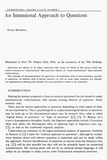Article
Full entry |
 PDF
(1.3 MB)
Feedback
PDF
(1.3 MB)
Feedback
 PDF
(1.3 MB)
Feedback
PDF
(1.3 MB)
Feedback
References:
[1] A. Church: A formulation of the simple theory of types. Journal of Symbolic Logic 5 (1940), 1, 56-68. MR 0001931 | Zbl 0023.28901
[2] D. Harrah: Communication: A Logical Model. M. I. T. Press, Cambridge, Mass. 1963. MR 0157790
[3] R. Hausser: The logic of questions and answers. Manuscript 1977.
[4] J. Hintikka: The intentions of intentionality and other new models for modalities. D. Reidel 1975. MR 0465797 | Zbl 0323.02029
[5] T. Kubiński: Wstęp do logicznej teorii pytań. Warszawa 1970.
[6] P. Materna: Eine Alternative zur intensionalen Logik Montague's. Linguistische Berichte 34 (1974), 34-39.
[7] P. Materna: Theory of types and data description. Kybernetika 14 (1978), 5, 313 - 327. MR 0512000 | Zbl 0402.68060
[8] J. F. Post: A defense of Collingwood's theory of presuppositions. Inquiry 8 (1965), 4, 332-335.
[9] A. Svoboda P. Materna K. Pala: An ordered-triple theory of language. Brno Studies in English, Vol. 12, (1976), Brno 159-186.
[10] A. Svoboda P. Materna K. Pala: The ordered-triple theory continued. Forthcoming in Brno Studies in English, Vol. 15 (1978).
[11] P. Tichý: An approach to intensional analysis. Noūs V/3 (1971), 273-297.
[12] P. Tichý: Introduction to intensional logic. Manuscript 1976.
[13] P. Tichý: Questions, Answers, and Logic. Amer. Philos. Quarterly 15 (1978), 4, 275 - 284.
[14] P. Tichý: What do we talk about?. Phil. of Sci. 42 (1975), 1, 80-93. MR 0479922

